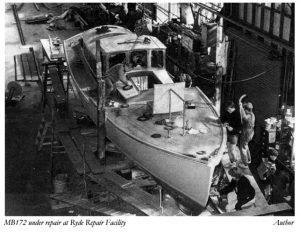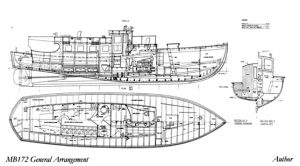- Author
- A.N. Other
- Subjects
- Ship histories and stories, Garden Island
- Tags
-
- RAN Ships
- None noted.
- Publication
- December 2012 edition of the Naval Historical Review (all rights reserved)
By Leyland Wilkinson
Leyland Wilkinson is a member of the NHS and was the former head of the trade school for apprentice training at the Garden Island Dockyard Training School, located at Rosebery.
In 1936 Garden Island Dockyard received an order to build two motor launches for use by District Officers in the Australian Territory of Papua New Guinea. Designated Motor Boats (MB) 168 and 172, they were built at the Garden Island Dockyard Boatshed and launched in 1937.
It would be interesting to know the specifications provided for these versatile craft as in his seminal work The Coast Watchers Eric Feldt, who prior to WW II was a District Officer in PNG, explains what was entailed in policing this rugged country with few roads where coastal voyages were the favoured form of transport. Feldt provides the context where these boats might have been used:
The district officer was responsible for all forms of government activity in his district, except public health. He was thus, with all local authority in his hands, a power in his district. In particular, the district officer was arbiter of the relationship between Europeans and natives – to him the native came with any complaint of ill-treatment. He was the kiap (a corruption of kapitän, a legacy from the German colonial era) who had power to settle the matter. An able and tactful district officer kept the wheels of the machinery of everyday life running smoothly, but an incompetent one invariably set section against section so that he had a constant turmoil on his hands. Worst of all was the district officer whose wife governed him and his district from the boudoir, but such were, fortunately, rare.
These robust boats were typical of Royal Navy craft of this period which had changed little in overall appearance since the early 1900s. However these craft were considered graceful and were readily distinguishable by their flowing lines and four cowl funnel ventilators mounted on the deck head and cabin. The wheelhouse was positioned amidships and accommodation to comfortably seat ten persons was situated aft of the wheelhouse. Entered through a forward hatch was further seating for another eight persons.
As fine examples of pre-war wooden boatbuilding skills these boats had carvel hulls built with teak planking and upper works on Australian spotted gum hardwood frames. The overall length was 39 ft 0½ inch, breadth 9 ft 6 inches and a depth (loaded) of 4 ft 5 inches. In their original configuration they were fitted with chromium plated guard rails.

As there is an extant photograph of MB 172 with the Fleet Oiler HMAS Kurumba in the background taken at Sydney in 1939 it is assumed both boats may have been first used by the RAN in Sydney. However in the early war years the two boats carried the Australian flag in the coastal waters of PNG. After the war the boats returned to naval service when they were re-designated as Senior Officers Boats and here their histories diverge.
MB 168 was first used as a tender to HMAS Rushcutter and later allocated to the General Manager of Garden Island Dockyard. She was then used as a duty boat transferring stores and personnel between Garden Island and the GID satellite boat building and repair facility (ex Halvorsen Yard) at Ryde. In 1989-1990 she was completely restored by Woodley Brothers at Berrys Bay. MB 168, which remains in active service, now forms part of the Naval Heritage Collection and is moored at Spectacle Island.
At one stage in the 1940s MB 172 saw service in Darwin before she returned south to be based at HMAS Lonsdale, being used by the Naval Officer-in-Charge Victoria. She later returned to Sydney allocated to the Commanding Officer HMAS Kuttabul.
In 1957 she was transferred to HMAS Creswell and used as a naval college tender until about 1970. She then appears to have been withdrawn from service and transferred as a restoration project for apprentice shipwrights at HMAS Nirimba. It was here that MB 172 was rediscovered in a poor state of repair with all fittings removed. The Australian National Maritime Museum (ANMM), recognising the historic significance of this craft, arranged for her restoration using the skills of apprentices being trained at Garden Island Dockyard.
While the original plans of these craft have been lost a replacement General Arrangement dated June 1989 was re-drawn from the original found at Nirimba. MB 172 was completely refurbished at the Ryde facility.
At this time the vessel was devoid of engines and most fittings. A replacement engine was provided under a sponsorship agreement with Eastern Engines Pty Ltd, the Volvo Penta distributors, and all the metal fittings were re-cast from existing patterns and made at the Garden Island foundry. The fittings were then taken to the Rosebery Technical Centre where they were completed and finished. The hull was later sheathed in fibreglass under another sponsorship with Epiglass and afterwards the boat was re-named Epic Lass.
After more than 75 years these exceptionally fine vessels continue to provide stalwart service in ferrying passengers between maritime events.
Now in 2012 the Naval Historical Society is pleased to donate to the ANMM the copy of the General Arrangement Plan and photograph of MB 172 which was used by GID Public Relations Officer in the Garden Island Magazine and other publications, plus a piece of timber from the original transom of this vessel with ‘MB 172’ in wooden outline. This latter item was salvaged from a skip on closure of the Rosebery Training Centre.





